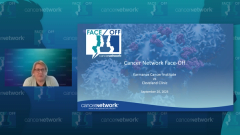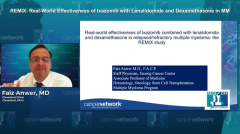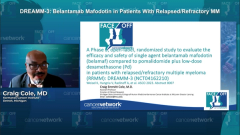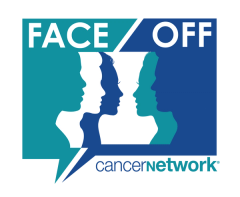
DREAMM-3: Belantamab Mafodotin in Patients With Relapsed/Refractory MM
Craig Cole, MD, reviews data from DREAMM-3 on the efficacy and safety of single-agent belantamab mafodotin in patients with relapsed/refractory multiple myeloma.
Episodes in this series

Transcript:
Judy Schreiber, PhD, RN: We’ll go on to the next presentation, which will be Dr [Craig] Cole presenting on the DREAMM-3 study [NCT04162210].
Craig Cole, MD: Thanks, and I was just an investigator on the DREAMM-6 study [NCT03544281]. I want to thank everyone for inviting me, and Dr Weisel for sharing her slides with me.
So belantamab mafodotin or Blenrep is a humanized anti-BCMA conjugated antibody. The DREAMM-2 Trial [NCT03525678] was a phase 2 trial that found efficacy in a 2.5-mg/kg dose with a response rate of 31% in that cohort given every 3 weeks. Back in the day that seemed to be this tremendous duration of response at 11 months, and I remember being super excited when DREAMM-2 came out because of how long that response rate was and this was one of the first anti-BCMA therapies available.
It was approved in August of 2020 for patients who have more than 4 lines of therapy, but we all knew about the eye toxicities, including the keratopathy, which led to the BLENREP REMS program and required an eye exam prior to each dose of therapy. DREAMM-3 was a superiority study trying to evaluate the efficacy and safety of single-agent belamaf [belantamab mafodotin] vs the doublet of Pom-dex [pomalidomide and dexamethasone]. As we have seen earlier, patients had a second relapse later.
[The study] screened 325 patients with greater than 2 lines of prior therapy, including Len [lenalidomide] and a proteasome inhibitor, whom they stratified based on stage and line of therapy.
Then randomizations, 2 to 1 for the Blenrep arm vs Pom-dex, and the doses of both Blenrep and Pom-dex were standard, and dosing for older patients, the dex was decreased to 20 mg. The primary end point was progression-free survival [PFS] and the usual secondary end points, and of note, this was an IV [intravenous] vs oral therapy that took place right smack in the middle of COVID-19.
So I give the authors credit for having a well-balanced randomized trial. I also give them credit for being a primary European study but also highlighting the number of black and African American patients in the trial. So they get kudos for that.
This number of prior lines of therapy was slightly higher in the Blenrep or the belamaf arm, at 4 median prior lines of therapy. And that is a lot of patients who had greater than 6 lines of therapy and almost double in the belamaf arm as compared to the Pom-dex arm.
So here was the highlight. At a median follow-up of 11.5 months for the belamaf and 10.8 for Pd [pomalidomide and dexamethasone], the medium PFS was longer for belamaf than Pom-dex but the PFS hazard ratio did not reach statistical significance with the belamaf being 11.2 months and Pom-dex being 7 months with a hazard ratio of 1.03. One thing to note, at SOHO [the Eleventh Annual meeting of the Society of Hematologic Oncology] I think, was like 2 or 3 weeks ago. They represented this data with an extra 10 months of analysis, and that hazard ratio improved from 1.03 up to 0.9. And I think I have a couple of other SOHO updates.
The overall response rates were similar between the 2 arms, 41% vs 36 %, but responses were deeper, and the belamaf arm for VGPR [very good partial response] and CR [complete response] and the higher MRD [minimal residual disease] negativity rate for the belamaf arm.
So for duration of response, the median follow-up was 11.5 months for belamaf and 10 months for the Pd. And the median duration of responses was longer. At this initial analysis, the belamaf was not reached. At 21.5 months the belamaf duration of response was found to be 25.6 vs the Pd at a longer follow-up and ended up being 10.4. So again, belamaf showed a longer duration of response than Pd.
Overall survival was similar between the 2 arms, almost identical at 21. That I don’t think changed at all with the longer analysis.
AEs [adverse events] interestingly enough were actually also pretty well balanced. With the grade 3 or 4 events, again, they were pretty well balanced, in the order of 50%, 30%, and 60%.
And, of course, the ocular events that for any-grade ocular events was about 66% and keratopathy was at 12%, and this study was performed when we had a really good idea of the management and handling of these ocular AEs with belamaf.
Another sort of interesting thing is how many patients were bothered because when we were doing the DREAMM-6 study, and when I was giving this as the standard of care, I was always worried about the patients going back and forth between eye doctors and seeing me. So this looked at patients being bothered where it was very much, quite a bit, and somewhat in those orange and warm colors, where the green colors were a little bit or not much at all. And over 70% of patients said they weren’t bothered at all by the treatment effects.
In conclusion, single belamaf vs Pom-dex didn’t reach the primary objective of PFS superiority. The belamaf had a longer median PFS and that was actually sustained even at the 10 additional months of analysis. However, the hazard ratio remained at 1.03, which improved to 0.9 with the most recent analysis. There were deeper responses in the belamaf arm, but because it didn’t meet its primary objective, it was withdrawn by the FDA in November of 2022. Patients already enrolled were able to receive it on compassionate use. And the belamaf research program is continuing forward with DREAMM-7 [NCT04246047] and DREAMM-8 [NCT04484623]. DREAMM-7 is belamaf, Velcade, [bortezomib], and dexamethasone vs daratumumab, Velcade, and dexamethasone in relapsed refractory [multiple myeloma]. And DREAMM-8 is with belamaf, pomalidomide, dexamethasone vs pomalidomide, bortezomib, and dexamethasone, and we have kind of an early signal. Dr Trudeau presented the ALGONQUIN trial [NCT03715478], which is a phase 1, and 2 on belamaf with pomalidomide and showed a pretty good response rate. So we’ll see how this looks moving forward. But I think a couple of points are that this study was done during COVID-19 comparing an IV vs a PO [oral] therapy. We really don’t have data on how many doses were missed or the intensity of therapy, and that would be interesting to know if COVID-19 played a role in this IV vs PO therapy.
Transcript is AI-generated and edited for clarity and readability.
Newsletter
Stay up to date on recent advances in the multidisciplinary approach to cancer.




























































































